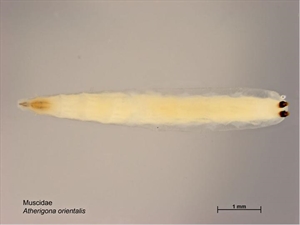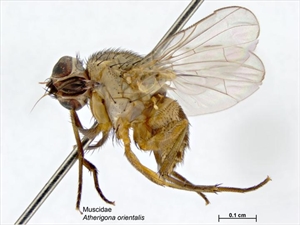Pepper fruit fly; it is also known as the tomato fruit fly.
Pacific Pests, Pathogens, Weeds & Pesticides - Online edition
Pacific Pests, Pathogens, Weeds & Pesticides
Pepper fruit fly (416)
Atherigona orientalis
Asia, Africa, North, South and Central America, the Caribbean, Europe (restricted), Oceania. It is recorded from Australia, Cook Islands, Federated States of Micronesia, Fiji, French Polynesia, Guam, Kiribati, Marshall Islands, New Caledonia, Niue, Northern Mariana Islands, Palau, Papua New Guinea, Pitcairn Islands, Samoa, Solomon Islands, Tonga, and Vanuatu.
Plants in the brassica, cucurbit, legume, potato, grass, and other families. The major hosts are beans, cabbage and cauliflowers, melon, orange, sorghum and tomato. Note, it has been found in the fruit of many other plant species, but it is difficult to know if it is the primary cause of the rot. The larvae can also bore into stems of members of the grass family; the stems are eaten at the base and can easily be pulled out - known as ‘deadhearts’ (see Fact Sheets nos. 408-412). Other hosts are decaying organic matter and waste, including rotting plant debris, faeces, dead animal bodies, and even other insects, dead or alive. It has been given the nickname, ‘trash fly’.
Maggots do the damage in many hosts but, as noted above, their presence in a rot does not always mean that they were the cause (Photo 1). Females are not able to lay eggs into hard tissues, hence the need to lay under the fruit calyx, into splits, cracks or rots - from physical damage and those made by other insects. The larvae damage both ripe and unripe fruit.
The fly is not a true fruit fly, i.e., a member of the Tephritidae, but belongs to the family of house flies, the Muscidae.
Eggs are about 0.9 mm long, hatching within a few hours into maggots that grow to 4-6 mm. Pupae are dark orange to dark red enclosed in the last skin of the larval moult. Adults are yellowish-grey flies, up to 4 mm long, wingspans of about 3 mm, with squarish heads (Photos 2&3). The thorax is dark, the tip of the scutellum (triangular plate on the back between the wings) is yellow, and the abdomen is also yellow.
The fruit fly is reported to be a primary host of capsicum in Nigeria and of tomato in Australia. There are also reports of high infestations on melons in Pakistan and rock melons in Queensland.
Look for rots in fruits; look for exist holes before searching for the yellow maggots. Look for deadhearts in members of the grass family.
BIOSECURITY
With such widespread distribution in the tropics CABI considers that the fly may have reached its potential distribution. However, New Zealand and Guatamala still consider it a pest of regulatory importance.
NATURAL ENEMIES
Parasitoid wasps from the encyrtid and chalcid families are reported attacking the pupal stage.
CULTURAL CONTROL
It is suggested to avoid chicken manure if it attracts the fly, especially if it appears to be the primary cause of damage of e.g., capsicums (or other crops). Use synthetic fertilizers instead.
Where attack occurs on members of the grass family (e.g., sorghum), refer to recommendations for rice stem borers (see Fact Sheets nos. 408-412).
RESTISTANT VARIETIES
From studies in Nigeria, it appears that the number of eggs laid on the peppers (Capsicum species) differs depending on the characteristics of the calyx, grooves in the fruit surface or the shape of the blossom end. It was speculated that the differences in egg number and therefore damage from larvae might be due to spiders finding niches on the fruits to make webs to capture eggs and larvae. Testing different varieties is recommended.
CHEMICAL CONTROL
Not recommended because in many cases it is unsure if the fly is the primary cause of damage. However, if fly numbers are high on capsicum, use neem (see Fact Sheet no. 402).
AUTHOR Grahame Jackson
Information from CABI (2017) Atherigona orientalis (pepper fruit fly) Crop Protection Compendium. (https://www.cabi.org/cpc/datasheet/7731); and from Hibbard KL et al. (2012) Pepper Fruit Fly Atherigona orientalis (Schiner) (Insecta: Diptera: Muscidae). Entomology and Nematology Department, Featured Creatures. UF/IFAS, University of Florida. (https://edis.ifas.ufl.edu/pdffiles/IN/IN94800.pdf). Photos 1-3 MAF Plant Health & Environment Laboratory (2011) Pepper Fruit Fly (Atherigona orientalis). PaDIL - http://www.padil.gov.au.
Produced with support from the Australian Centre for International Agricultural Research under project HORT/2016/185: Responding to emerging pest and disease threats to horticulture in the Pacific islands, implemented by the University of Queensland and the Secretariat of the Pacific Community.






